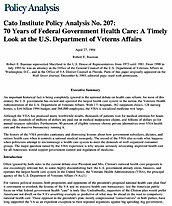Although the VHA has produced many worthwhile results, thousands of patients wait for medical attention for hours every day, hundreds of millions of dollars are paid out in medical malpractice claims, and billions of dollars go for annual taxpayer subsidies. Furthermore, 90 percent of eligible veterans choose private alternatives over VHA health care and the massive bureaucracy running it.
The history of the VHA provides cautionary and distressing lessons about how government subsidizes, dictates, and rations health care when it controls a national medical monopoly. The record of the VHA also reveals what happens when politicians attempt to micromanage a health care system to meet the demands of well-organized consumer groups. The major question raised by the VHA experience is why anyone seriously advocating improved health care for all Americans would support government control and regulation of medicine.

